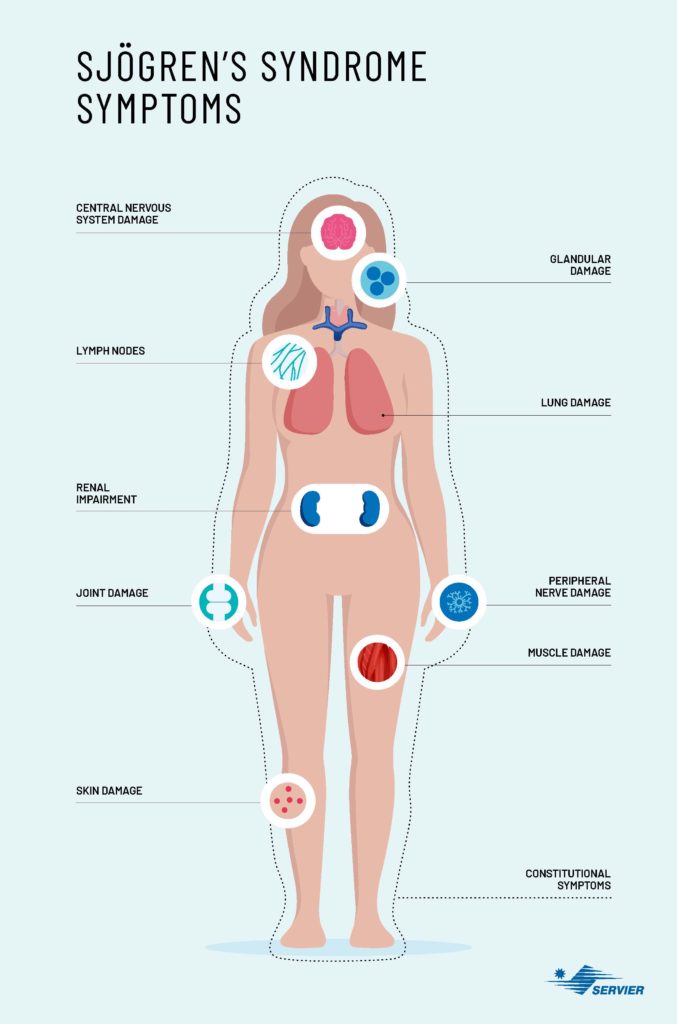Sjögren’s syndrome is the second most common autoimmune disease after rheumatoid arthritis. Linked to a disorder of the immune system, Sjögren’s syndrome is characterized by lymphocyte infiltration (a type of immune cell) in the salivary and lacrimal glands, most often results in a dry mouth and dry eyes, and is often associated with joint pain and fatigue. In a third of cases, damage to other organs occurs. There is currently no treatment preventing the progression of the disease with existing therapies focused on relieving symptoms only.

Sjögren’s syndrome is an autoimmune disease (a disorder in which the immune system dysfunctions and abnormally attacks the body’s own components). It destroys the glands, particularly the salivary and lacrimal glands (glands that produce saliva and tears).
60,8
Number of people out of 100,000 who have Sjögren’s syndrome, one of the most common chronic systemic autoimmune diseases.
90 %
90% of sufferers are women1
50
Average age of diagnosis. The disease can occur at any age, including in children, but that is rare2.
The causes of Sjögren’s syndrome are not known. Sjögren’s syndrome is considered a multifactorial disease in which environmental factors trigger immune system dysregulation in genetically predisposed people.
Two forms of the disease
Sjögren’s syndrome can either be primary (isolated) or secondary (associated with another autoimmune disease, such as lupus, rheumatoid arthritis, or scleroderma). It is a chronic, slowly progressing disease that requires long-term follow-up adapted to the initial severity of the symptoms and/or the evolution of the disease3.
Symptoms:
These symptoms are present in more than 80% of patients and are responsible for a large deterioration in quality of life and loss of productivity at work, mainly due to intense fatigue.
30% of patients will also have systemic involvement, which means that many organs are affected, such as lymph nodes, skin, lungs, kidneys, blood vessels, as well as the peripheral and/or central nervous system4.
Patients with Sjögren’s syndrome also have a greater risk, 15 to 20 times more than the general population, of developing lymphoma; a cancer of the lymphatic system.5

Difficult to diagnose…
The slow progression of the disease and the various non-specific manifestations make it difficult to diagnose from the start, and doctors from different specialties are often consulted. However, some tests are able to confirm the diagnosis:


… And difficult to treat
At the present time, no treatment has demonstrated effectiveness in preventing the progression of the disease, so treatment consists solely of symptomatic therapies.
Patients must first and foremost adapt their lifestyle:
Treating the symptoms of dry eyes or mouth includes using eye drops, salivary substitutes, drugs that stimulates salivary secretion, etc. Medicinal products such as analgesics, non-steroidal anti-inflammatory drugs, and low-dose corticosteroids can be used to treat pain.6
Severe organ damage is treated with therapies used in other autoimmune diseases, such as lupus. A non-specific immunosuppressive treatment may be prescribed in order to reduce or modulate the hyperactivity of the immune system.6
In each and every case, patients should be regularly monitored because of the many side effects the treatments may cause, especially the risk of infection.
Several clinical trials are currently being conducted in Sjögren’s syndrome with treatments, mostly monoclonal antibodies, acting on different immunological mechanisms involved in the disease.
And Servier ?
Through a partnership with OSE Immunotherapeutics, Servier is conducting two separate Phase 2 studies with a monoclonal antibody directed against the interleukin 7 receptor (IL-7R, a pro-inflammatory cytokine receptor). Servier is leading a study in primary Sjögren’s syndrome as IL-7R is highly expressed in the salivary glands.
Meanwhile OSE Immunotherapeutics is developing the same compound in ulcerative colitis, an immuno-inflammatory disease primarily affecting the large intestine.
Specifically committed to primary Sjögren’s syndrome, Servier is also actively involved in addressing other autoimmune diseases, including pemphigus vulgaris and spontaneous chronic urticaria, two disorders affecting the skin.
REMEMBER
[1] https://www.sjogrens.org/understanding-sjogrens/frequently-asked-questions
[2] https://www.sjogrens.org/understanding-sjogrens/frequently-asked-questions
[3] https://medecinepratique.ma/evolution-et-suivi-du-syndrome-de-gougerot-sjogren/
[4] https://public.larhumatologie.fr/grandes-maladies/maladies-auto-immunes/syndrome-sjogren/comment-se-manifeste-le-syndrome-de-sjogren
[5] https://www.sjogrens.org/understanding-sjogrens/symptoms
[6] https://www.chu-nimes.fr/federation_maladies_dysimmunitaires/patients-le-syndrome-de-gougerot-sjogren.html
